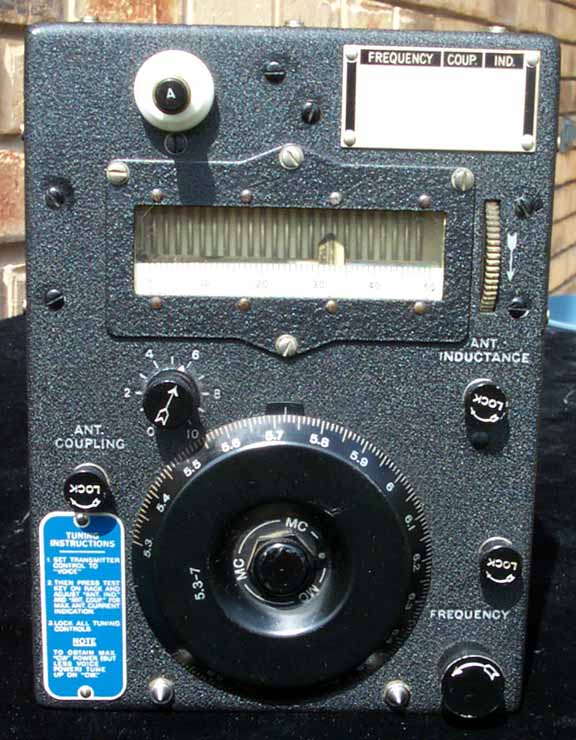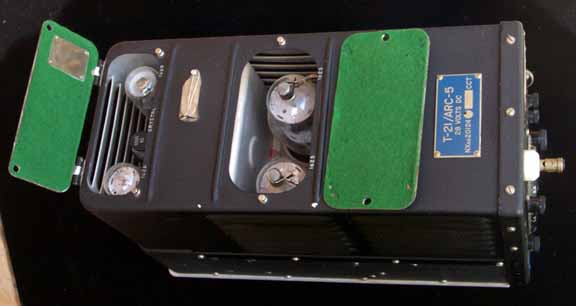I've obviously been using a lot of the little WWII 1626 tubes building all
of the Darling amps, and generating interest causing lots more to be
built, and they aren't as plentiful as they once were. I bought about
36 of them in the last couple of weeks, from some non-eBay tube sellers
and some from eBay. The average price is about $ 6 now.
It's interesting that even though the tubes look positively identical,
except for batch color variations of the bakelite bases, I was trying
to match up some pairs and had 14 different labels and manufacturers !
A 1626 is also referred to as a VT-137 ... some guy on eBay has them
listed as "rare" and priced at $ 27.95 each ! I emailed him and made
a reasonable offer, and he said his prices were reasonable !
1626 Tubes
7 posts
• Page 1 of 1
everything you never wanted to know about the 1626
These 1626s were used in the WWII vintage AN/ARC-5 "Command Set" transmitters (as well as other radio gear of the era), the ARC-5 Xmitters used two 1625s, one 1626, and a 1629 "magic eye" tube, which was used to indicate antenna tuning and matching. A 1625 is basically an 807 with a 12V filament, and a 7-pin UX style base. Call it the Great uncle of the 6BG6G, etc...
The 1626 served as the Variable Frequency Oscillator, the two 1625s served as the RF power amplifiers, and the 1629 served to calibrate the frequency dial against a fixed-frequency crystal (this was a very long time before the concept of digital frequency synthesis)
I know, this post is worthless without a picture, so here's a full frontal shot:

The RF came off that nice little terminal marked "A" on the front, and could make your fingers really "tingle" if you dared to touch it, (and probably say lots of words, that you never learned in Sunday School)


The top view:
The 1626 is located lower left corner, the 1629 next to it, and the mirror in the lid was used as a "periscope" so the operator could tune up the RF output and match the antenna.
I'll try to find a clear interior view, and add it later.

Meanwhile, here is some more general information:
http://www.smecc.org/an_arc-5.htm
Typically, these transmitters each covered a single, somewhat narrow, band of frequencies, and the set consisted of several transmitters, covering more or less continuously from 500KHz to at least 9.1 MHz,
(I used to have the one which covered 7.0 to 9.1 MHz, perfect for the 40 meter ham band). The set also included some VHF AM components which covered 100-156 MC, in two bands, and these used another of Tom's favorite tubes, the 832A. There were also matching receivers, and a separate modulator for AM transmission, as well as morse-code CW operation. Power for each unit was supplied by a small on-board Dynamotor which took the aircraft's 24-28 VDC and stepped it up to whatever B+ voltages were necessary.
There was also a 190-500 KHz receiver, for navigational use. The 500-1500 KHz series receivers (and even more so, the matching transmitters) were very desirable, and hard to find. I'd imagine that more than one bootleg / pirate AM radio station used these

To quote the Late and Great John J. Meshna, there must have been one of these radios (and transmitters) produced for every man, woman, child, and dog in the USA... These were used in WWII era B-17s, and many other military aircraft, and after the war, became the staple for many young budding radio amateurs.
These ARC-5 sets still show up at hamfests and swapmeets, in varying states of condition (mostly pretty well worn-out these days). I'd SWAG that they will still be around 100 years after the war ended...
/ed B in NH
The 1626 served as the Variable Frequency Oscillator, the two 1625s served as the RF power amplifiers, and the 1629 served to calibrate the frequency dial against a fixed-frequency crystal (this was a very long time before the concept of digital frequency synthesis)
I know, this post is worthless without a picture, so here's a full frontal shot:

The RF came off that nice little terminal marked "A" on the front, and could make your fingers really "tingle" if you dared to touch it, (and probably say lots of words, that you never learned in Sunday School)



The top view:

The 1626 is located lower left corner, the 1629 next to it, and the mirror in the lid was used as a "periscope" so the operator could tune up the RF output and match the antenna.
I'll try to find a clear interior view, and add it later.

Meanwhile, here is some more general information:
http://www.smecc.org/an_arc-5.htm
Typically, these transmitters each covered a single, somewhat narrow, band of frequencies, and the set consisted of several transmitters, covering more or less continuously from 500KHz to at least 9.1 MHz,
(I used to have the one which covered 7.0 to 9.1 MHz, perfect for the 40 meter ham band). The set also included some VHF AM components which covered 100-156 MC, in two bands, and these used another of Tom's favorite tubes, the 832A. There were also matching receivers, and a separate modulator for AM transmission, as well as morse-code CW operation. Power for each unit was supplied by a small on-board Dynamotor which took the aircraft's 24-28 VDC and stepped it up to whatever B+ voltages were necessary.
There was also a 190-500 KHz receiver, for navigational use. The 500-1500 KHz series receivers (and even more so, the matching transmitters) were very desirable, and hard to find. I'd imagine that more than one bootleg / pirate AM radio station used these


To quote the Late and Great John J. Meshna, there must have been one of these radios (and transmitters) produced for every man, woman, child, and dog in the USA... These were used in WWII era B-17s, and many other military aircraft, and after the war, became the staple for many young budding radio amateurs.
These ARC-5 sets still show up at hamfests and swapmeets, in varying states of condition (mostly pretty well worn-out these days). I'd SWAG that they will still be around 100 years after the war ended...
/ed B in NH
Last edited by EWBrown on Wed Dec 31, 2014 10:40 pm, edited 7 times in total.
Real Radios Glow in the Dark
-

EWBrown - Insulator & Iron Magnate
- Posts: 6389
- Joined: Wed Mar 19, 2003 6:03 am
- Location: Now located in Clay County, NC !
I guess it would stand to reason that a potentially good source for these tubes might be various army surplus stores around the country. I'll start calling my local stores up.
-

wiredbecker - KT88
- Posts: 301
- Joined: Mon Mar 26, 2007 3:48 pm
- Location: Albany Landfill, CA
There used to be a huge government surplus depot in the East Bay or Vallejo that schools could go to for anything from file cabinets to searchlight generators. A little discrete poking around might bear fruit.
Eric in the Jefferson State
- erichayes
- KT88
- Posts: 987
- Joined: Fri Jan 23, 2004 9:01 pm
- Location: McKinleyville CA
Property Disposal 101
Back in the 80s and earlier (before it got shut down) Fort Devens in Ayer Massachusetts would occasinally hold "property disposal" auctions and sales, usually as "pallet loads". The rub was that you had to take the entire lot or pallet load, including the 557 rabbit cages and 47 ten gallon kitchen pots, and seven moldy, sweat-stained straitjackets, that often accompanied that nice receiver or signal generator. No cherry pickin' allowed, one had to take it all, or take nothing (and then have to pay additional cash to have the stuff hauled away after the deadline)...
I remember reading about a huge military surplus dealer in San Antonio who, back in the mid 1970s, ended up with several NOS / NIB M-2 "Ma Deuce" .50 calibre machine guns in their original wooden crates and coated with "cosmoline", that he obtained (unknowingly) as part of a huge property disposal lot. Someone in the miliary P-D unit "screwed the pooch", big time...
He didn't discover that he had the M-2s until a couple years later, and he decided to be a "good guy" and tried to donate them to the local FBI office. He got into such a deep pile of legal hassle, that he said if he got any more of them, he'd just shush up and bury or destroy them...
/ed B in NH
I remember reading about a huge military surplus dealer in San Antonio who, back in the mid 1970s, ended up with several NOS / NIB M-2 "Ma Deuce" .50 calibre machine guns in their original wooden crates and coated with "cosmoline", that he obtained (unknowingly) as part of a huge property disposal lot. Someone in the miliary P-D unit "screwed the pooch", big time...
He didn't discover that he had the M-2s until a couple years later, and he decided to be a "good guy" and tried to donate them to the local FBI office. He got into such a deep pile of legal hassle, that he said if he got any more of them, he'd just shush up and bury or destroy them...
/ed B in NH
Last edited by EWBrown on Wed Dec 31, 2014 10:28 pm, edited 2 times in total.
Real Radios Glow in the Dark
-

EWBrown - Insulator & Iron Magnate
- Posts: 6389
- Joined: Wed Mar 19, 2003 6:03 am
- Location: Now located in Clay County, NC !
Most of the 80 or so 1626's I have were made by RCA. It even says so on the Western Electric boxes. One exception in construction I've found is that some of the Hytron samples have an additional mica plate at the bottom, like a shield to contain the getter flash near the bottom of the envelope. Not all of the Hytrons have this construction, though.
- Kyle K
- Posts: 29
- Joined: Tue May 09, 2006 2:38 pm
- Location: Mililani, HI
HeapKit A-4
Apparently the Heathkit A-4 mono amp used three 1626s as gain stages and phase splitter, and 12A6s as the PP output stages. This was in the days when Heath's chief tube and parts supplies were based on the ready (and inexpensive) availability of WWII surplus electronic parts. Then there was their original Condenser (capacitor) checker, which used a 1626 as the power supply's half-wave rectifier - with the grid and plate connected together (oh, what a sacreliege)
/ed B in NH
/ed B in NH
Real Radios Glow in the Dark
-

EWBrown - Insulator & Iron Magnate
- Posts: 6389
- Joined: Wed Mar 19, 2003 6:03 am
- Location: Now located in Clay County, NC !
7 posts
• Page 1 of 1
Who is online
Users browsing this forum: No registered users and 10 guests
